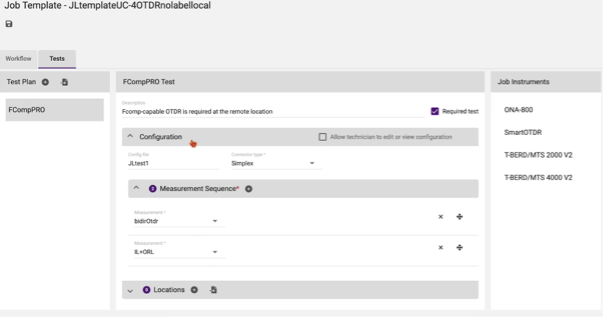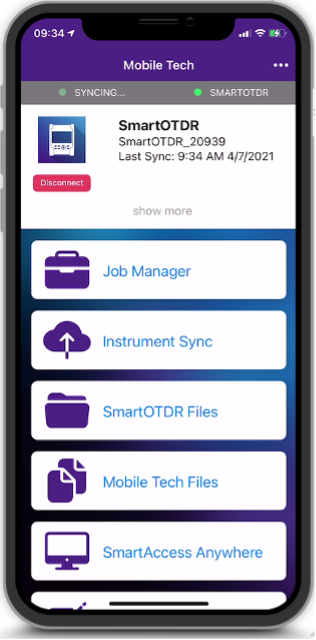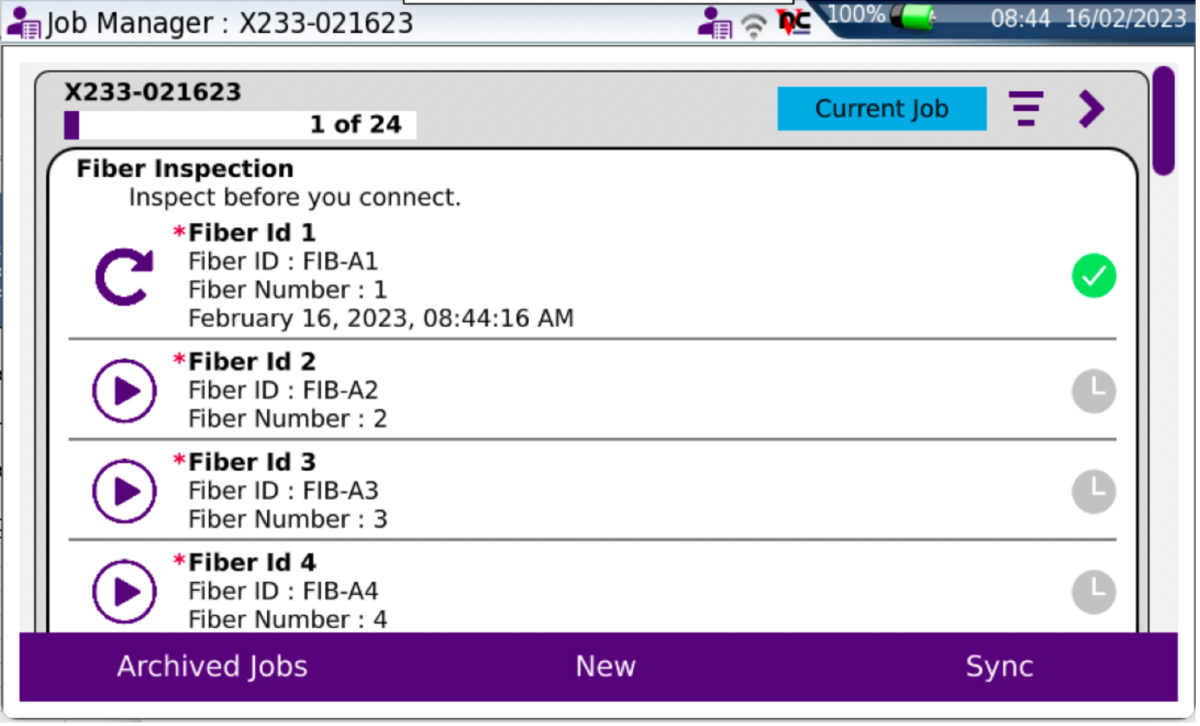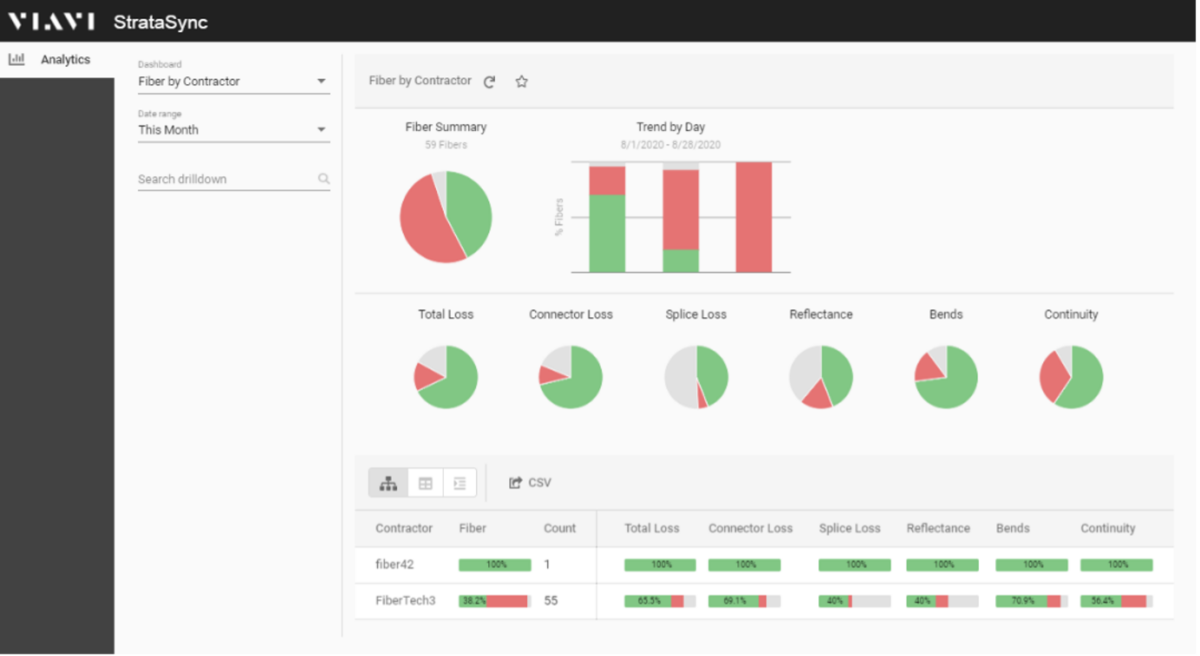Job Efficiency: How to Scale Processes, Job Allocation, and Tracking for High-Fiber-Count Projects

As in other areas of a project that involves the deployment of high-fiber-count cables, the tasks of process control, job allocation to techs/contractors, and progress tracking can become unwieldy, cumbersome, and unmanageable in terms of the time and effort required. Just like the testing and certifying of the individual fibers and managing the volume of test results, legacy methods for project management do not scale well for high-fiber-count projects.
Traditionally, you would outline the processes to be followed, the test setup, the pass/fail criteria, results format, progress reports, how you want information to be submitted back to a project manager, and reporting intervals in a Methods of Procedure (MOP) or some similar document. Then create a master spreadsheet with all the fibers listed, complete with ID number, date due, date tested, status, date passed, and other necessary information. Extracts from this would be taken and sent to your tech managers/contractors to indicate the work they are allocated, probably sent via email, Dropbox, or some other secure file transfer and returned at regular intervals so a project manager can copy/paste the individual updates into the master spreadsheet and thus track project progress and generate reports as required.
It’s a very manual process and one that can consume an unreasonable amount of time. It’s also a process that can suffer from delays or inaccuracies due to techs/contractors not updating spreadsheets in a timely manner, submission delays or human errors with manual data entry, copy/paste and so on.
This may be controllable or acceptable enough when you are dealing with 60, 80, or even 100 fibers though simple brute force of spending the time to manage everything. But these issues can and will worsen in line with the size of a project and the number of fibers involved as this also drives the use of more contractor companies and sub-contractors. Once you start getting into projects with thousands of fibers, that approach does not work. Scaling up the time taken on these tasks, chasing for updates, the risk of human errors, correcting issues, and so on becomes time/effort prohibitive (ineffective/inefficient). This can lead to loss of project visibility and issues being missed as the reporting isn’t keeping up with deployment/testing progress resulting in rework (site revisit, time, money) and possibly delays in signing off fibers or even a whole project.
Then there is the issue of ensuring test/process consistency to make sure links are built to or comply with specifications. Or do you just let folks get on with it and hope they read your MOP and actually follow it?
Without some kind of control over the test/job process there will be challenges to deliver the kind of high-quality asset that will require minimal maintenance, which will support high speed/value services, and deliver a return on investment (if there are investors involved, they will want proof that their money is not being wasted).
So, the question should be, when it comes to high fiber count deployments, how best to approach project management in a better and more efficient way?
A centralized approach is still key to reducing the overall time and effort of project management, but you have to adopt or utilize better mechanisms for defining test criteria and process, allocating jobs, deployment to techs/contractors, retrieving results, and project tracking/reporting.
To maintain test consistency, you must be able to define the test setup and pass/fail limits you require as a template which can then be handed to all tech/contractors or rather downloaded to their instruments. The system/tool/process you use should also allow you to scale and apply those templates to any number of fibers without additional effort or need to create test tasks for each individual fiber or tech.
Pre-defined templates help prevent variations/deviations from the prescribed test setup, which could result in poorer quality fiber links passing when they should be failed. A template deployed to instruments approach also scales very easily and efficiently for a larger number of techs/contractors associated with high-fiber-count deployments.

Centralized Job Template
Then to ensure build quality, the list of actions and tests for each fiber/job should be extracted from your MOP and presented as a checklist of tasks integrated within the test instrument and tied to any test results. This will ensure that no steps, checks, or tests are missed (accidentally or otherwise) and enforce that your MOP is followed.
The creation of test templates and allocation of jobs (or fibers to be tested) as a project has to be through a centralized system, and these days in order to provide easy access from anywhere this is usually a cloud-based solution. To avoid any of the issues mentioned, deployment should be direct to the instrument and as most modern testers are cloud/internet enabled that can be easy enough. Just connect an instrument to a local network via ethernet or WiFi and perform a sync to your centralized system. For situations and locations where there are no local networks, tethering an instrument to a smartphone and using a mobile tech application can achieve the same thing.

Mobile Tech App
Presenting the allocated testing assignments via a job manager on the instrument would remove the need to input job information manually, minimize any risk of human error with any data entry (fiber IDs and job numbers for example), and eliminate the need for progress tracking via a separate spreadsheet.

Instrument Job Manager
Regular syncing of an instrument would retrieve the job checklists, test results, and pass/fail status so that information can be immediately incorporated into a dashboard to show real-time project progress. Dashboards provide the project visibility required, not only to show overall progress but they also allow identification of potential bottlenecks like someone behind schedule or highlighting issues like a consistently failing test. Being able to quickly glance and see how close are you to a due date for test or a phase of sign-off/handover means you can take corrective action before things become overdue or develop into future problems. Dashboards can also give clearer insight into issues such as missing results or incomplete job tasks (although using a job manager on an instrument or mobile tech app should help prevent most of that in the first place). Plus, they can help identify if there is any coaching required by identifying techs/contractors who are consistently submitting failed tests. Since you have the data that feeds the dashboard, you can perform further analysis of any potential red flags to determine a root cause, things such as contaminated end-faces, macro bends, and bad splices from either poor construction techniques or poor workmanship/fiber handling at any point in the process. Having this information not only lets you take immediate action, but also provides insight into where technicians may need further training/education.

Fiber Construction Dashboard – Deep Dive Analysis
This central cloud system delivering to synchronized instruments approach does away with the need to email spreadsheets back and forth, along with the manual work to consolidate information and generate reports. Plus it would all be available immediately for everyone on the team, whenever required, and accessible from anywhere. Reporting also becomes easier when it’s all in the cloud: a person in another part of the country or world can easily log in and extract whatever information is needed.
With everything integrated together in one place, time is saved, mistakes are prevented, and teams are aligned. Implementing a solution to manage both contractors and directly employed techs with all of the attributes mentioned above will save significant time and effort when it comes to project management and reporting. But, critically, due to those capabilities, it will give clear project progress visibility and can be scaled efficiently for larger number of techs/contractors associated with high-volume fiber deployments for metro and access build/upgrade and dark fiber builds.
Leveraging this kind of approach equips team members with the information and resources they need to complete jobs with real-time visibility from start to finish that ultimately results in fewer problems, greater ROI, and happier customers.
At VIAVI we refer to all of this as Test Process Automation (TPA). To learn more about our TPA solution visit our TPA web page.
This blog is part of a 7-part series on bidirectional fiber testing. The rest of the series can be found here:
- Why Perform Bi-directional Fiber Testing?
- What the Standards Say About Bi-directional OTDR Testing
- Single-Unit vs Dual-Unit Test for Bi-directional OTDR Certification
- Is OTDR Testing Using a Loopback Method the Most Efficient Option for Fiber Certification?
- How to Efficiently Scale Full Bi-directional Certification for High Fiber Count Cables
- The Impact of Test Equipment Implementation on Full Bi-directional Test: Time Studies
Dou glas Clague is currently solutions marketing manager for fiber optic field solutions at VIAVI. Doug has over 20 years of experience in test and measurement with a primary focus on fiber optics and cable technologies, supporting the telecommunications industry. Prior to VIAVI, Doug held positions as manufacturing engineer, solutions engineer and business development manager. Doug has participated on numerous industry panels around fiber and cable technology trends. He attended Brunel University in London and graduated with an honors degree in electrical and electronic engineering.
glas Clague is currently solutions marketing manager for fiber optic field solutions at VIAVI. Doug has over 20 years of experience in test and measurement with a primary focus on fiber optics and cable technologies, supporting the telecommunications industry. Prior to VIAVI, Doug held positions as manufacturing engineer, solutions engineer and business development manager. Doug has participated on numerous industry panels around fiber and cable technology trends. He attended Brunel University in London and graduated with an honors degree in electrical and electronic engineering.



